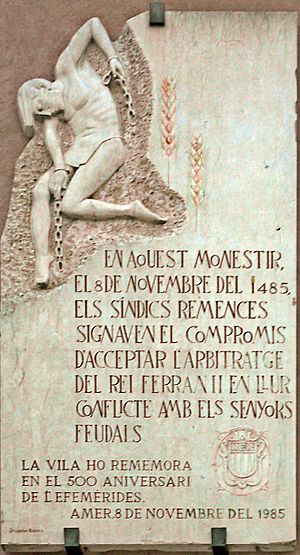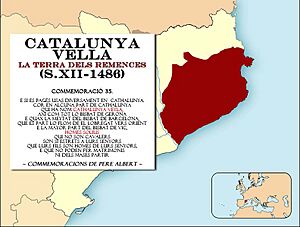Old Catalonia facts for kids
Old Catalonia (called Catalunya Vella in Catalan) was a special idea from the past. It was a legal term created by a smart Catalan lawyer named Pere Albert in the 1200s. He used it to describe certain parts of Catalonia where a specific group of farmers, called remensa peasants, lived.
These farmers were found in areas like the Girona region, the eastern part of the Vic region, and the part of Barcelona that was east of the Llobregat river.
In the 800s and 900s, these areas, like much of ancient Marca Hispanica, were pretty free for farmers. But by the 1000s, things changed. Powerful nobles started to make life harder for the farmers. They added many unfair rules and taxes, known as "evil customs."
By the 1100s, the situation got even worse. Nobles used their power to stop farmers from leaving their land. This was especially true as new lands were being won in the south by leaders like Ramon Berenguer IV. To keep farmers from running away, nobles "attached" them to their land, turning them into remensa peasants. This meant they couldn't leave without paying a fee.
What Was Old Catalonia?
At the end of the 1200s, the lawyer Pere Albert wrote an important book called Commemorations. This book explained all the laws and customs used in Catalonia at that time. To help define where the remensa peasants lived, Albert came up with the idea of Old Catalonia.
He said Old Catalonia included:
- The region around Girona.
- Half of the Barcelona region, specifically east of the Llobregat River.
- Most of the Vic region.
Pere Albert created Old Catalonia to be different from another area called New Catalonia. According to him, New Catalonia had already been named in the 1100s during the time of Ramon Berenguer IV. The Llobregat river was the natural border between Old and New Catalonia.
In his book, Albert explained the legal situation of farmers in both Old and New Catalonia. He showed how the rules for farmers were different depending on which side of the Llobregat River they lived on.
The End of Old Catalonia
By the 1400s, there were big conflicts like the War of the Remensas and the Catalan Civil War. These wars were partly about the unfair treatment of the remensa peasants.
Finally, in 1486, King Ferdinand II of Aragon issued a special decree called the Sentencia Arbitral de Guadalupe. This important law freed the remensa peasants from the "evil customs." Once the farmers were free, the idea of Old Catalonia, which was all about where these specific farmers lived, became less important and eventually disappeared.
How Historians Used the Name

Later historians, in the 1500s and 1600s, also used the name Catalunya Vella. People like Pere Gil and Onofre Manescal noticed that some areas, like the counties of Roussillon, Cerdanya, Urgell, Pallars, and Ribagorza, didn't fit into either Old Catalonia or New Catalonia as Pere Albert described them.
This was because the special laws called the Usages of Barcelona didn't apply in these areas. To fill this gap, and just for geography, some historians like Pere Gil created a new name: "Catalunya Novísima" (meaning "Very New Catalonia") for these five counties.
Sometimes, the term Old Catalonia has also been wrongly used to mean all of the Catalan counties that existed before New Catalonia was conquered. It has also been used to describe the wetter parts of Catalonia, but this doesn't include the coastal areas. Interestingly, a part of Old Catalonia roughly matches the area where the central Catalan dialect is spoken, reaching as far south as the plain of Tarragona.
See also
 In Spanish: Cataluña Vieja para niños
In Spanish: Cataluña Vieja para niños


